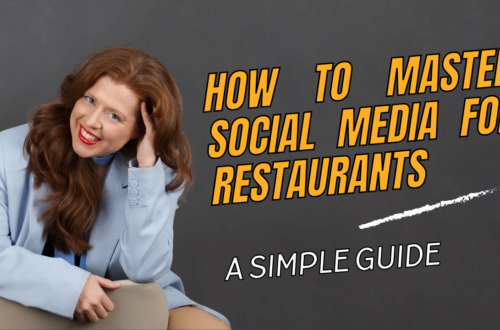Top 5 Text Mistakes to Avoid When Writing for Restaurants
Have you ever experienced the frustration of writing a post, describing a new dish, searching for the perfect photo to accompany it, and… nothing? No likes, no engagement, no increase in guests. Each time this happens, it can feel disheartening, leading to thoughts like, “Either my social media strategy isn’t effective, or I simply don’t know how to write.” In this article, I will highlight the top 5 mistakes to avoid when writing texts for a restaurant.
Placing the Restaurant at the Center of the Text
The first critical mistake that undermines all further efforts is placing the restaurant at the center of the text.
Consider this example:
“Introducing our new strawberry menu. A unique blend of ingredients and vibrant flavors promises an unforgettable dining experience in our exquisite atmosphere.”
Do similar texts populate your restaurant’s social media profile?
Let’s break it down.
Firstly, the focus is on the restaurant itself, almost boasting about its qualities. Secondly, there’s an overuse of lofty words like “unique,” “vibrant,” and “unforgettable,” which often add little substance. What exactly constitutes an “exquisite atmosphere”?
These vague terms not only fail to convey meaningful information but also risk being perceived as mere noise. Removing these embellishments leaves us with, “We have a new strawberry menu.” Now, why should this interest the guest?
Firstly, the focus is on the restaurant itself, almost boasting about its qualities. Secondly, there’s an overuse of lofty words like “unique,” “vibrant,” and “unforgettable,” which often add little substance. What exactly constitutes an “exquisite atmosphere”?
These vague terms not only fail to convey meaningful information but also risk being perceived as mere noise. Removing these embellishments leaves us with, “We have a new strawberry menu.” Now, why should this interest the guest?
Skipping a Strong Hook
In today’s world, people are overwhelmed with information, so creating engaging content is just one piece of the puzzle. The other crucial aspect is capturing the attention of potential customers.
I often notice that amazing dishes, special offers, and restaurant events get lost in the sea of content. Is there something that can help you immediately stand out from the rest? Absolutely—it’s having a strong hook for your post.
A hook will encourage users to pause their scrolling and delve into your post. In today’s fast-paced social media world, a hook is indispensable for making a memorable first impression and setting your content apart from the constant stream of information users encounter daily.
If you’re interested in examples of compelling hooks for restaurant text, check out this article.
Neglecting to Address the Guest’s Needs
The text must resonate with the guest, making them feel it’s about them. Otherwise, why should they bother reading it?
Remember, you’re not just competing with other restaurants; you’re competing for attention among the vast expanse of online content. Your post should speak directly to the individual, addressing their desires and needs.
Failure to Maintain a Consistent Tone of Voice
This is a widespread mistake. It often occurs because a restaurant operator has not clarified what tone their restaurant’s brand communicates with customers. Is it formal, casual, inspirational, friendly, or humorous?
It all begins with the basics of marketing: who your target audience is, what value your restaurant provides to these people, and how you want them to perceive the establishment.
All of this leads to an understanding of what tone of voice will be best for your establishment.
Lack of Proper Formatting
Always use paragraphs to ensure readability. Consider this comparison. Which is easier to read?
A long unbroken string of text?
Lorem ipsum dolor sit amet, consectetur adipiscing elit, sed do eiusmod tempor incididunt ut labore et dolore magna aliqua. Integer feugiat scelerisque varius morbi enim nunc faucibus. Euismod lacinia at quis risus sed vulputate odio. Adipiscing diam donec adipiscing tristique. Commodo quis imperdiet massa tincidunt nunc pulvinar sapien et. Eu mi bibendum neque egestas congue quisque egestas diam. Diam vel quam elementum pulvinar etiam non quam lacus suspendisse. Fusce ut placerat orci nulla pellentesque. Pretium fusce id velit ut tortor pretium viverra. Eu ultrices vitae auctor eu augue ut lectus arcu. Eleifend quam adipiscing vitae proin sagittis nisl.
Or a structured format with clear breaks?
Lorem ipsum dolor sit amet, consectetur adipiscing elit, sed do eiusmod tempor incididunt ut labore et dolore magna aliqua. Integer feugiat scelerisque varius morbi enim nunc faucibus.
Euismod lacinia at quis risus sed vulputate odio. Adipiscing diam donec adipiscing tristique. Commodo quis imperdiet massa tincidunt nunc pulvinar sapien et. Eu mi bibendum neque egestas congue quisque egestas diam. Diam vel quam elementum pulvinar etiam non quam lacus suspendisse.
Fusce ut placerat orci nulla pellentesque. Pretium fusce id velit ut tortor pretium viverra. Eu ultrices vitae auctor eu augue ut lectus arcu. Eleifend quam adipiscing vitae proin sagittis nisl.
People naturally gravitate towards text that’s easier on the eyes. Make it effortless for them to engage with your content.
In summary, when crafting texts for your restaurant, prioritize the guest. Identify their desires and demonstrate how your establishment can fulfill them. By keeping the guest as the focus of the text, you can create compelling content.





